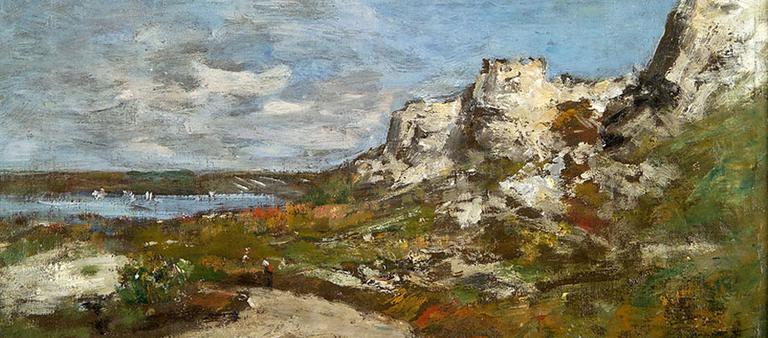
Côte de Plougastel et rade de Brest
Eugène Boudin (1824 Honfleur - 1898 Deauville)
1871
Huile sur toile ; signée « E Boudin » en bas à droite ; 23,5 x 41,5 cm
Provenance :
Paris, collection Gustave Cahen ; Paris, Drouot, 5 juin 1929 ; Londres, Alex Reid & Lefevre Gallery ; Londres, collection privée ; Paris, collection Le Polyptyque ; Paris, collection privée
Bibliographie :
Robert Schmit, Eugène Boudin, vol. I, Paris, 1973, n° 711.
Bibliographie comparative : Denise Delouche, « Les peintres et la Bretagne vers 1870 », Annales de Bretagne, vol. 77, n° 2, 1970, p. 417-470.
Eugène Boudin occupe une place à part dans l’impressionnisme. Trop jeune pour accompagner Corot (qu’il rencontrera plus tard) et les peintres de Barbizon. Plus âgé d’une demi-génération que Monet et ses amis, qu’il côtoie sans les rejoindre tout à fait (même s’il participera à leur première exposition, en 1874, et partagera le même marchand, Durand-Ruel).
En 1871 il a quarante-sept ans, au mitan de la vie. Il a beaucoup peint les plages à la mode, particulièrement Trouville. Mais le Second Empire est défait, la France occupée, les élégantes ne sortent plus guère. Et puis, dit-il, « cette plage de Trouville qui faisait naguère mes délices n’a plus l’air à mon retour que d'une affreuse mascarade. Il faut presque du génie pour tirer parti de cette bande de fainéants poseurs » (Georges Jean-Aubry, Eugène Boudin d’après des documents inédits, Paris, 1922). Alors il voyage, en Bretagne d’abord, le pays de sa femme, précisément ici les environs de Plougastel. Plus tard à Anvers, en Hollande, et jusqu’à Venise, la série des ports.
On est à l’automne 1871. L’heure est sombre. Plus qu’aux irisations de l’impressionnisme, c’est à la facture âpre, aux rudes tonalités de Courbet, rencontré en 1859, que renvoie ce paysage dont on trouve un équivalent, à l’état d’étude (les mêmes rochers vus dans la direction inverse) au musée du Havre.
Denise Delouche a bien décrit la méthode du peintre à ce moment : « Boudin comme Corot sait choisir l’angle de vue, l’emplacement de son chevalet de façon telle que la toile est déjà composée, c’est la courbe d’une grève ou l’oblique d’une masse de rochers qui rattachent les lointains au premier plan. » En plein air, comme c’est le cas ici, le peintre part de ce qu’il voit, et déplace le cadre à sa guise (comme en photographie : ce n’est pas un hasard si la première exposition impressionniste prendra place dans l’atelier de Nadar).
Gustave Cahen, grand collectionneur des Impressionnistes, exécuteur testamentaire et premier biographe de l’artiste, fut le premier propriétaire de ce tableau qui passa en Angleterre après la vente de ses collections en 1929.
